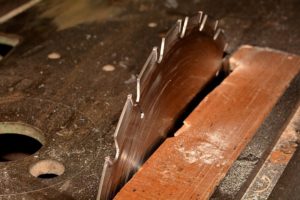
Saw blades come in many different shapes and sizes, all with different purposes
Saw blades come in many different shapes and sizes, all with different purposes. You will need a specific saw blade for your project depending on the material you are working with. It can be very confusing deciding between all the various blades. However, choosing the right blade is important for ensuring your project turns out right in the end. While there are specialized tools for cutting nearly every material, you can easily switch the blade on your saw to cut different materials without making any changes to the saw. Here is a quick overview of different saw blades and what materials they work best with.
Wood Saw Blades
Saw blades are most often used for wood, and because of that, there are several options for woodcutting blades. The three most common types are:
Cross-cut: Designed for cutting lumber across the grain
Rip-cut: Designed for ripping along the grain of the wood
Combination: A mixture of cross-cut and rip-cut designs which create a blade that can do both operations.
The teeth of your saw blade are also very important. The size, shape, and spacing of the saw teeth determine the finish of your cut. Generally, blades with more teeth yield a smoother cut, and blades with fewer teeth remove material faster. Festool has a wide selection of wood saw blades of varying sizes to fit with any project.
Metal Saw Blades
Metal blades are configured differently than wood blades. There are two main types: cut-off and carbide blades. Cut-off wheels are inexpensive tools used for the basic cutting of thick metals, and carbide blades have steel teeth that are long-lasting and can cut almost any type of metal. However, the tooth count on metal blades starts higher than it does for wood. Therefore, you want a lower tooth count for thicker materials for metal blades, and a higher tooth count for thin metal to avoid tearing and denting the material. For a good quality metal saw blade, check out the Festool collection here.
Bottom Line
So what saw blade should you get? It is ultimately up to your needs and preferences. Hopefully, you now have more insight into which blade is best for your work. Generally, it is good to remember the difference between a saw blade that cuts wood with the grain and one that cuts against the grain. Also, the more teeth on the blade means a more precise cut at a slower speed.
Hardwood Flooring from Jason Brown Wood Floors
At Jason Brown Wood Floors, our commitment to quality installation is clear in all that we do, which is why our customers consistently rate us as one of the top contractors in the region. We have been awarded Baltimore Magazine’s Best of Baltimore Award 4 times and have been proudly serving the Baltimore Area for over 16 years. If you’re ready to speak with someone about your hardwood flooring project, we want to hear from you! Contact us at 410-668-9131 or send us a message here.
Jason Brown Wood Floors is also your convenient dealer of high-quality, professional grade power tools. We offer brands that tradespeople trust most for the job. Come check out our Abingdon showroom to browse the in-stock selection of products and tools by Festool, Freud, Diablo, Shaper, Mirka, Makita, Saw Stop , and Grex
Keep up with us on Facebook, Twitter, Pinterest, Houzz, and YouTube, and check out our blog for more news and information!


